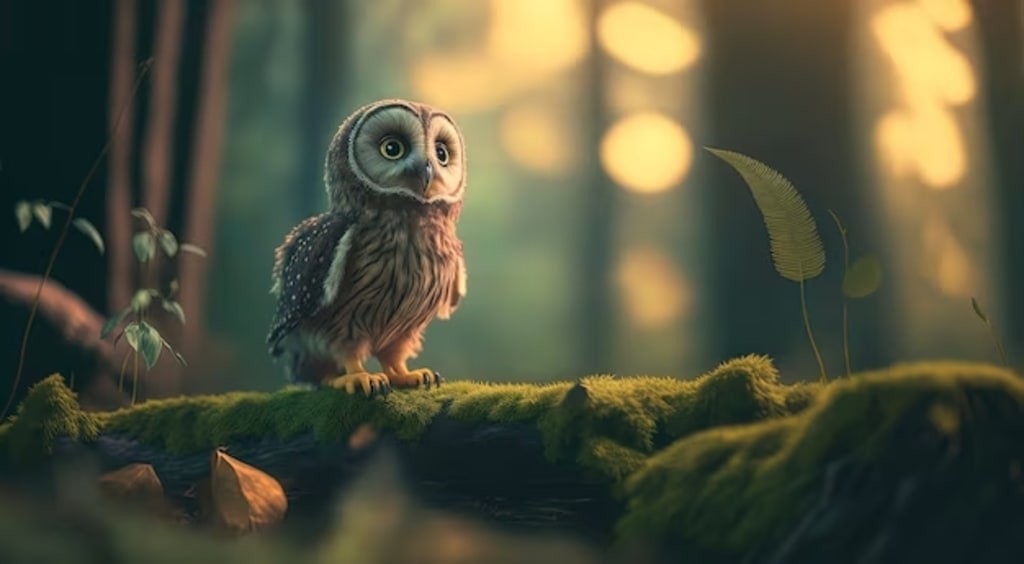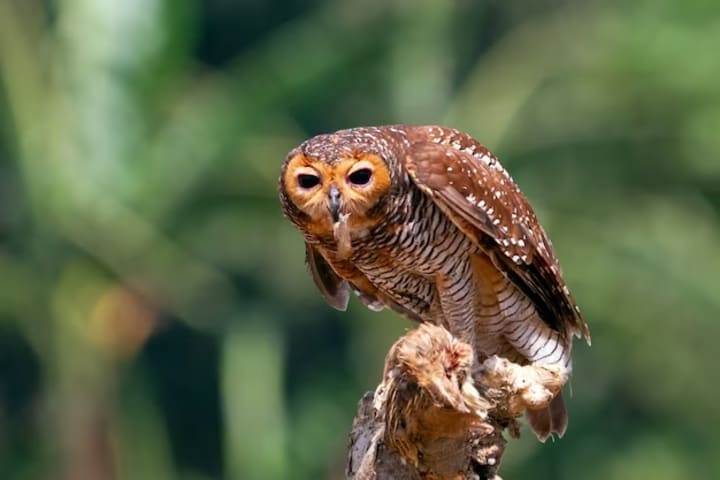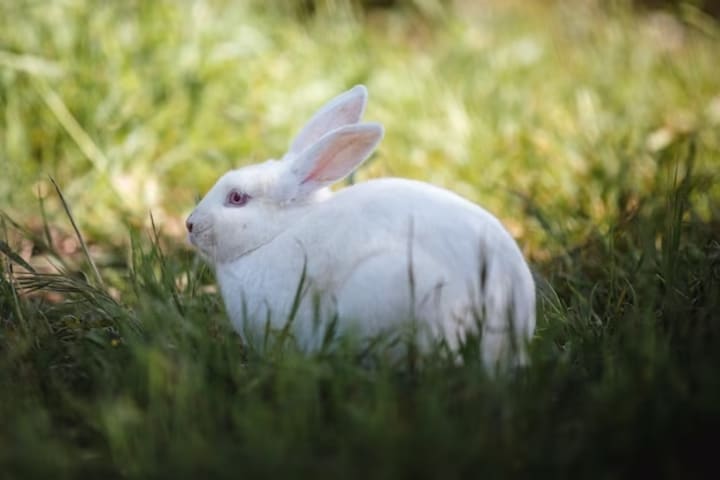Talking Owl Saves Rabbit
story about an animal that can talk

Once upon a time, in a lush green forest, there lived a wise old owl named Hoot. Hoot was not an ordinary owl, he had a special ability to talk. He could communicate with all the creatures of the forest, big or small, and was known as the mediator among them.
One day, a young rabbit named Thumper came to Hoot for help. Thumper was in trouble and needed Hoot's assistance. He had been captured by a group of hunters and was being kept in a cage. Thumper knew that Hoot was the only one who could help him and he begged for his help.

Hoot was taken aback by Thumper's predicament and quickly got to work. He gathered all the animals of the forest and explained Thumper's situation to them. The animals knew that they needed to help Thumper and they came up with a plan.
The animals waited until nightfall when the hunters had gone to sleep. Then, they quietly made their way to where Thumper was being kept. Hoot, being the wisest of them all, led the group and directed the animals on how to open the cage without waking up the hunters.
With Hoot's guidance, the animals were able to free Thumper from the cage and take him back to his family. Thumper was overjoyed and grateful to Hoot and all the animals who had helped him.

From that day on, Hoot's reputation as the mediator of the forest grew even more. All the animals knew that they could count on him to help them in times of need, and they looked up to him as their leader.
Thumper was always grateful to Hoot, and the two of them became the best of friends. They would often sit and talk for hours, discussing the goings-on of the forest and planning for the future. And with Hoot's guidance, the animals of the forest lived in peace and harmony, knowing that they could always count on their wise old friend.
Owls Characteristics & Behaviour
Owls are a unique and fascinating species of bird that are known for their distinct physical characteristics and behaviors. Here are some features of owls that make them stand out from other birds:
Large eyes - Owls have large eyes that face forward, giving them binocular vision and excellent depth perception. Their eyes are also fixed in their sockets, which means they have to rotate their heads to see in different directions.
Nocturnal - Most owl species are nocturnal, which means they are active at night and sleep during the day. This is because their eyes are adapted for low-light conditions, making them excellent hunters in the dark.
Silent flight - Owls have specially adapted feathers that allow them to fly silently through the air. This is because their feathers are covered in small hair-like projections that break up the sound of the air moving over them.
Powerful talons - Owls have powerful talons that are designed for grasping and holding onto prey. They have sharp, curved claws that can exert a crushing force of up to 500 pounds per square inch.
Facial disks - Many owl species have facial disks, which are circular arrangements of feathers around their eyes. These disks help to focus sound waves and improve their ability to locate prey by hearing alone.
Camouflaged plumage - Owls have excellent camouflage, with feathers that blend in seamlessly with their surroundings. This helps them to hide from predators and sneak up on prey.
Overall, owls are fascinating animals with a unique set of physical and behavioral adaptations that make them well-suited to their nocturnal lifestyle.
Rabbit Characteristics & Behaviour
Rabbits are small, herbivorous mammals that are found in a wide range of habitats around the world. Here are some of the key characteristics and behaviors of rabbits:
Herbivorous diet - Rabbits are strictly herbivorous, meaning they feed exclusively on plant material such as grasses, leaves, and bark.
Excellent hearing - Rabbits have large ears that are capable of picking up even the slightest sounds. This is because they are prey animals and need to be able to hear approaching predators.
Rapid reproduction - Rabbits are known for their rapid reproductive rate, with females able to produce several litters of offspring per year.
Burrowing behavior - Many rabbit species are burrowers and will dig underground tunnels and chambers as a way of protecting themselves from predators and harsh weather conditions.
Social animals - Rabbits are social animals that often live in groups or pairs. They communicate with each other through a range of vocalizations and body language.
Fast runners - Rabbits are known for their speed and agility, with some species able to run up to 50 miles per hour in short bursts.
Inquisitive nature - Rabbits are naturally curious and inquisitive animals that will explore their surroundings and investigate new objects and smells.
Coprophagy - Rabbits engage in a unique behavior called coprophagy, which involves eating their own feces as a way of obtaining important nutrients.
Overall, rabbits are fascinating animals with a range of unique characteristics and behaviors that make them well-adapted to their environment. They are social, inquisitive, and agile, and play an important role in many ecosystems around the world.
Conclusion of the above story, the story of the talking owl who saved the rabbit is a heartwarming tale of friendship, bravery, and kindness. Hoot, the wise old owl, used his unique ability to communicate with animals to rally the creatures of the forest and help Thumper, the young rabbit, who was in trouble.
About the Creator
Vikas Mishra
Your dreams shape the future, so stop wasting time and go to work!
Enjoyed the story? Support the Creator.
Subscribe for free to receive all their stories in your feed.






Comments
There are no comments for this story
Be the first to respond and start the conversation.